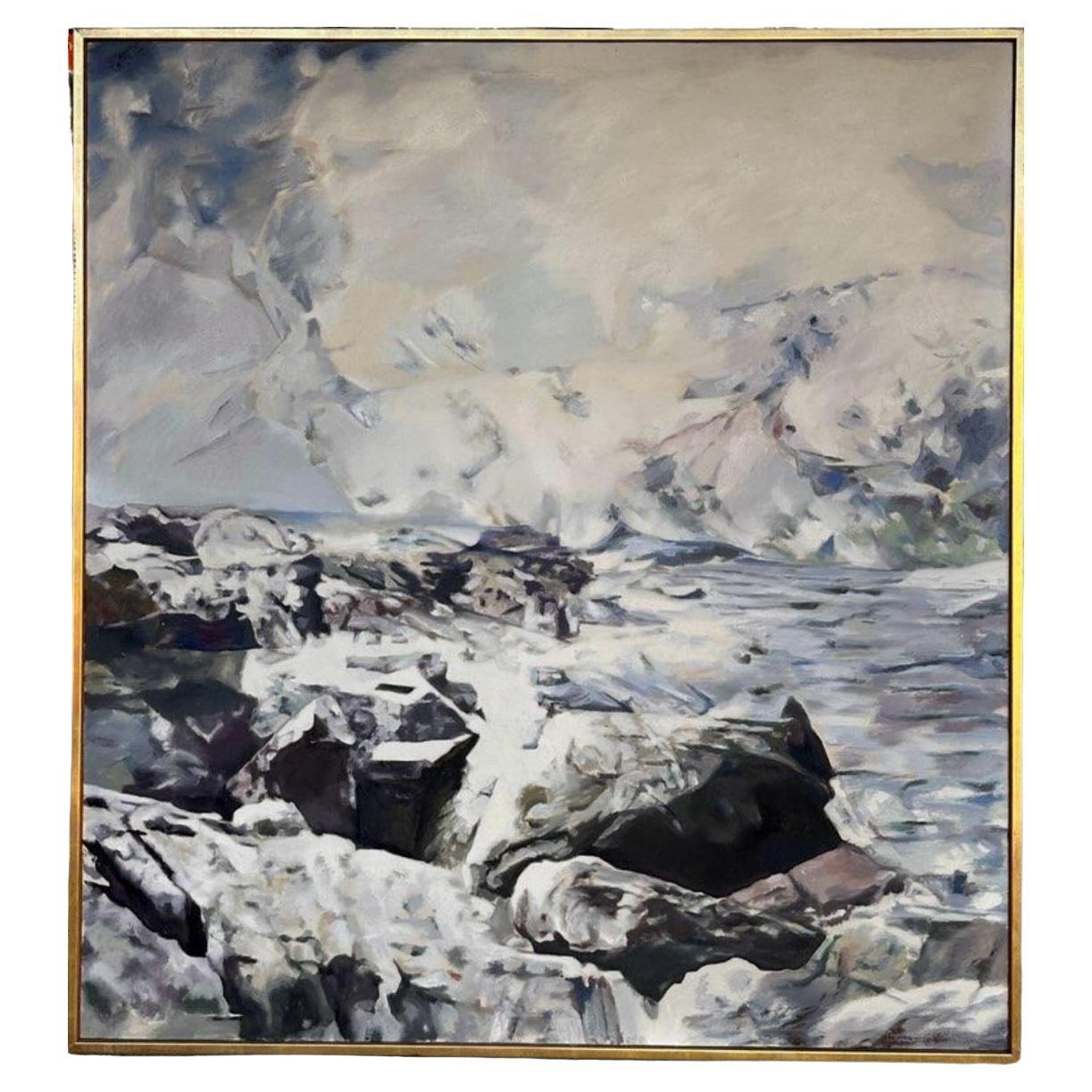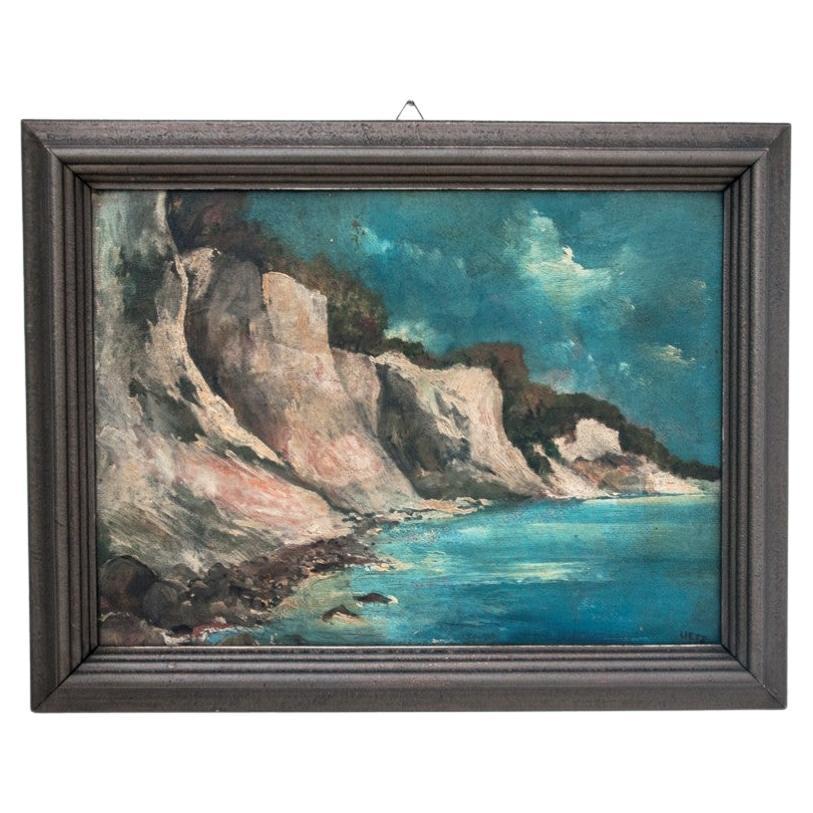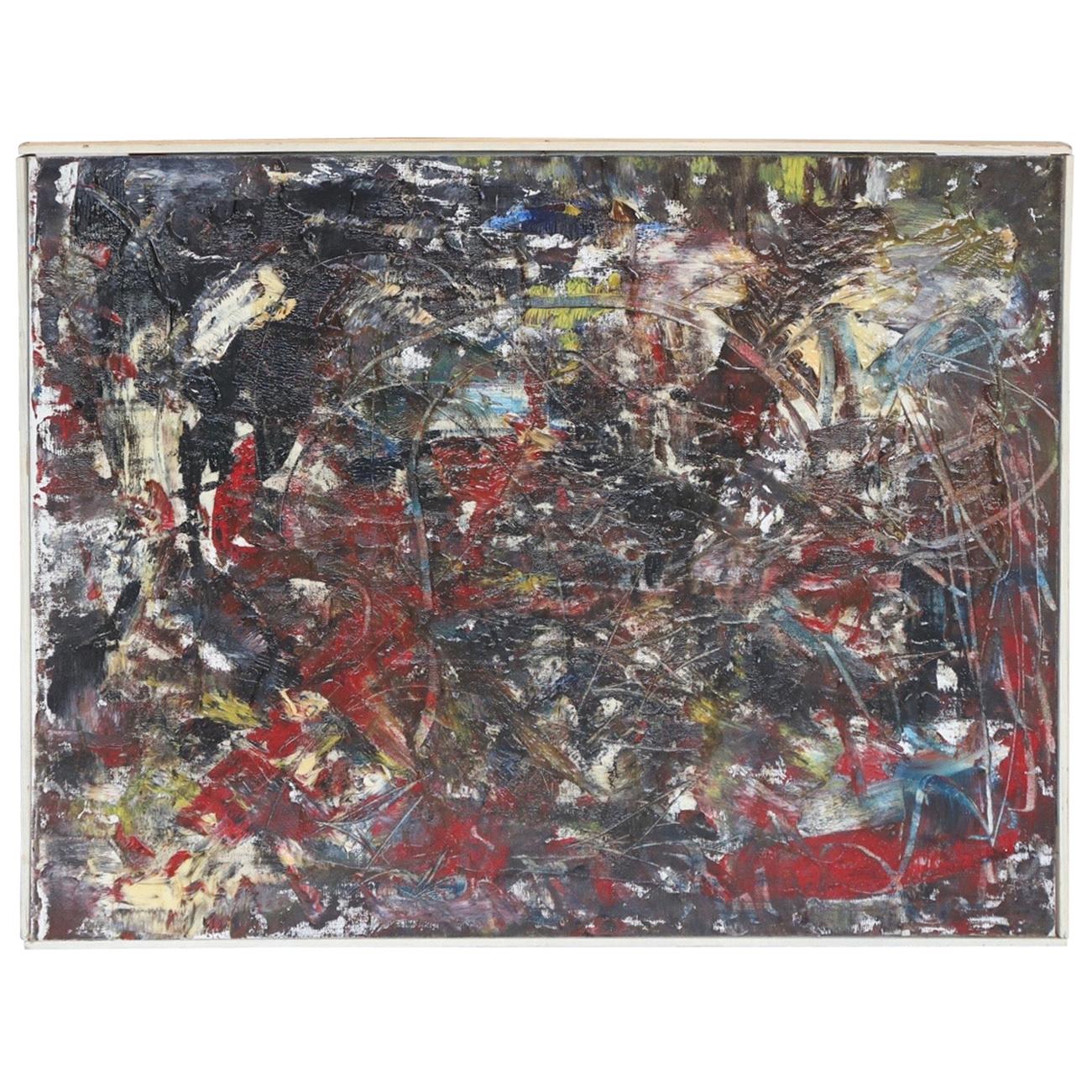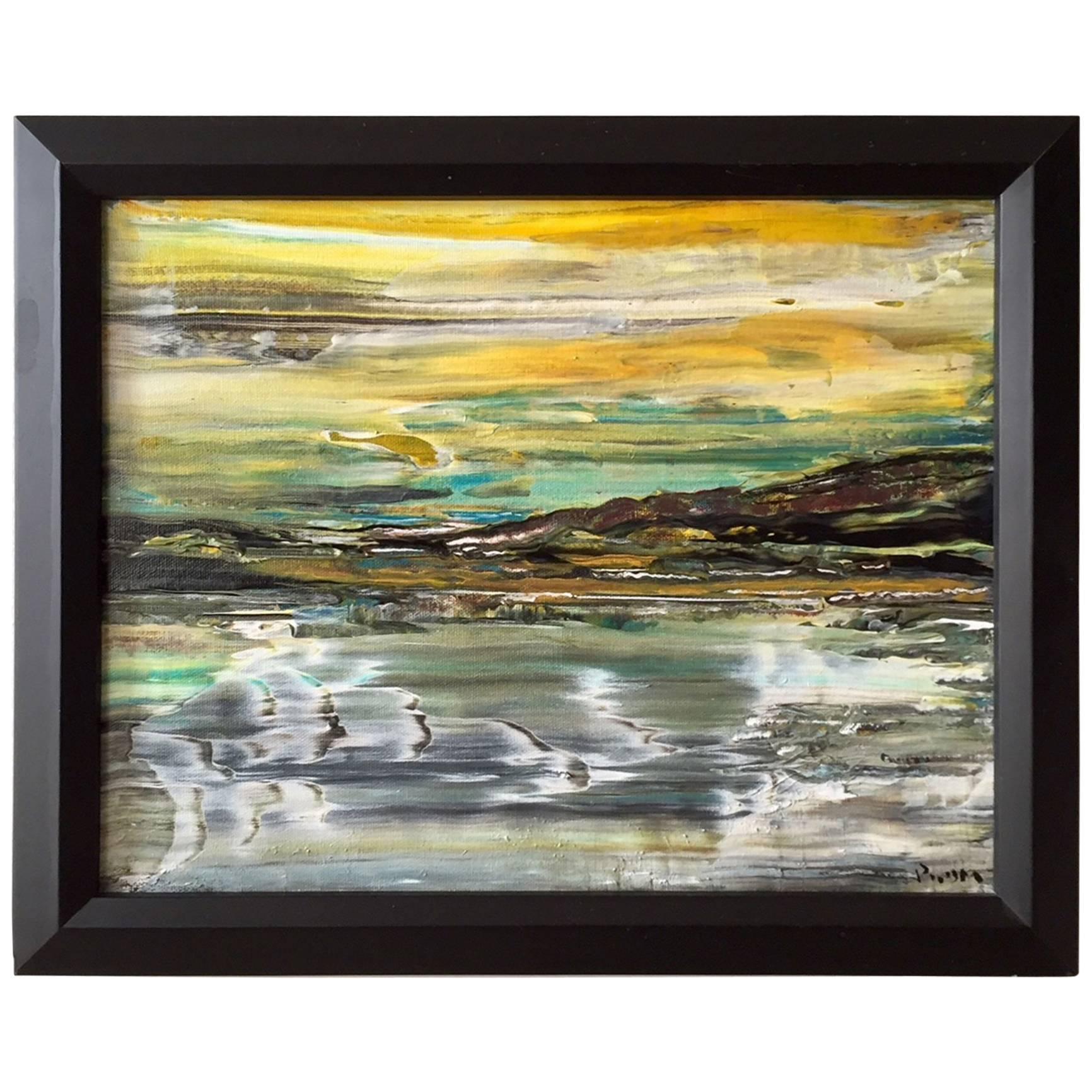Items Similar to Balcomb Greene "The Cliffs", 1978
Want more images or videos?
Request additional images or videos from the seller
1 of 13
Balcomb Greene "The Cliffs", 1978
About the Item
The Cliffs by Balcomb Greene painted in 1978. Signed on the front titled and dated on the reverse.
Paintings of the Montauk coast by Balcomb Greene are few and far between. This painting likely created at his Studio in Montauk New York. Painting is in excellent original condition and retains the original gallery frame.
provenance: Estate of Gertrude B. Pascal / Gifted from the previous in 1987, The Frances Lehman Loeb Art Center, Vassar College, Poughkeepsie, NY / Christie's, New York 2012 / Private Collection, New Jersey
Public collections:
Baltimore Museum of Art, Baltimore, MD
Brooklyn Museum, Brooklyn, NY
Cleveland Museum of Art, Cleveland, OH
The Art Institute of Chicago, Chicago, IL
Corcoran Gallery of Art, Washington, D.C.
Guild Hall, East Hampton, NY
Wadsworth Atheneum, Hartford, CT
Museum of Fine Arts, Houston, TX
Indianapolis Museum of Art, Indianapolis, IN
Metropolitan Museum of Art, New York, NY
Museum of Modern Art, New York, NY
National Museum of American Art, Washington, D.C.
Joslyn Art Museum, Omaha, NE
Pennsylvania Academy of the Fine Arts, Philadelphia, PA
Norton Simon Museum, Pasadena, CA
Portland Museum of Art, Portland, OR
Neuberger Museum, Purchase, NY
Solomon R. Guggenheim Museum, New York, NY
Parrish Museum, Southampton, NY
Whitney Museum of American Art, New York, NY
Walker Art Center, Minneapolis, MN
Butler Institute of American Art, Youngstown, OH
Boca Museum of Art, Boca Raton, FL
Over a lifespan of 86 years, Balcomb Greene followed his muse wherever it led, unfettered by what had come before, unafraid of where the future might lead. Despite a series of different pathways explored, his purpose remained ever constant: to express truth as he found it and communicate it to a broader audience. In the 1930s, Greene was a young artist committed to abstraction as his expressive language. Greene’s paintings and collages of the 1930s reflect the influence of Pablo Picasso and Piet Mondrian and put him in the company of fellow Americans, including Ibram Lassaw, Josef Albers, Ilya Boltowsky and George L. K. Morris, all among the founding members, in 1936, of American Abstract Artists.
John Wesley Greene, his christened name which he never legally changed, was born in 1904 in Millville, New York, the third child and only son of Methodist minister The Reverend Bertram Stillman Greene (1864–1929) and Florence Stover Greene (1876–1911). His family on both sides were Revolutionary-era colonists, originally living in Connecticut and Vermont before joining the Yankee migration to the western frontier of New York State. In 1922, John Wesley Greene enrolled at Syracuse University aided by a scholarship for the sons of Methodist ministers and intending to fulfill the promise of his name and follow his father into the ministry. As with so many before and after him, the liberal education he absorbed at Syracuse broadened his horizons and reshaped his life plan. Studying philosophy, psychology, and literature, along the way he separated himself from organized religion. During his senior year, on a visit to The Metropolitan Museum of Art in New York City, Greene was introduced to Gertrude Glass (1904–1956), an art student and the Brooklyn-born daughter of Latvian Jewish immigrants.
Following Greene’s graduation, the two married in 1926 and went to Europe. They stopped briefly in Paris but spent most of their time in Vienna where Greene had a fellowship to study psychology. When they returned to New York in 1927, Greene enrolled in a master’s program in ‘English literature at Columbia University. When his thesis advisor rejected his essay topic on the “fallen woman” in seventeenth-century literature as inappropriate, he left without a degree. From 1928 until 1931, Greene taught English at Dartmouth College in Hanover, New Hampshire. At some point, he stopped using his given name, John, and began to call himself, more distinctively, Balcomb, the family name of his paternal grandmother.
While Greene wrote three novels (all unpublished) during his teaching years at Dartmouth, his wife was a working artist, and he eventually developed an interest of his own in painting. In 1931, Greene gave up his teaching position and he and Gertrude went to Paris, determined to immerse themselves in the modern art ferment they had briefly experienced in their earlier visit. For young Americans with no prescribed agenda, a receptiveness to innovation, and wide-open eyes and minds. Paris, in 1931, offered a rich stew of approaches to modern art. The city absorbed and transmuted an international mélange of styles—cubism, orphism, futurism, dadaism, constructivism, neoplasticism, suprematism, de Stijl, Bauhaus—France encountering Holland, Germany, Italy, and Russia with Pablo Picasso from Spain, Constantin Brancusi from Romania, and Jacques Lipchitz from Lithuania. As a sculptor, Gertrude Greene was fascinated by the constructivism of the Russian brothers Naum Gabo and Antoine Pevsner as well as the work of Brancusi, Jean Arp, and Jacques Lipshitz. Initially, according to plan, Gertrude sculpted while her husband continued to write. Soon, however, Greene felt the pull of the expressive possibilities of paint and registered for instruction at the Académie de la Grande Chaumière, an inexpensive and loosely organized school.
Balcombe Greene found in abstraction the means of communication that had eluded him as an aspiring minister, as a psychologist, and as a teacher and writer of fiction. Artists had long recognized the influence of hidden geometries in influencing viewer’s perceptions and reactions to their works. Twentieth-century abstraction or “non-objective” art, dispensed with recognizable figural images and manipulated geometry and color, aiming, as with earlier art, to reach the viewer on a level below conscious awareness. This would be art in a new language for a new society, appealing to the senses but free from the baggage of the past and the accusation that photography had rendered art pointless. Balcomb Greene’s abstraction was essentially an optimistic art, its clean geometries conveying the anticipation of the better future that science and technology appeared to promise to citizens of the twentieth century, most especially to Americans.
Balcomb and Gertrude Greene returned to New York City in 1932, invigorated by the possibilities for their art, but facing a catastrophic general financial depression that severely curtailed the ability of fine artists to earn a living. They settled in Greenwich Village surrounded by fellow artists. The Greenes plunged into arts advocacy, active participants in the American Artists’ Union, founded in 1933 to agitate for government support for struggling artists. Balcomb Greene’s literary powers of persuasion found an outlet in Art Front, the magazine of the Artist’s Union published from 1934 to 1937 where he was a regular contributor as well as a member of the editorial board. He scrambled for any work he could find work, until about 1935 when political pressure was rewarded with a series of New Deal programs designed to put artists to work to produce public art funded by public money. Abstract art, however, continued to be an outlier, both for public money and for acceptance of work by Americans into major museum shows and collections. Politically it proved an irresistible target for elected officials who happily appointed themselves as the sensible guardians of the taxpayers’ money. Even in the art world where abstraction was appreciated as a European avant-garde import, the work of Americans working in the style was dismissed as derivative and thus largely ignored.
In 1936, a group of abstract artists began meeting to explore possibilities for group exhibitions. Balcomb and Gertrude Greene were among a nucleus of nine artists involved in the discussions. A general call to expand the effort went out. In January 1937, a large meeting of artists agreed to form an organization to be called American Abstract Artists, a general enough name to accommodate the diversity of styles included within the group. Balcomb Greene served as the first chairman of American Abstract Artists and as chairman again in 1939 and 1941. He was a major contributor to its charter and edited and wrote for its annual yearbook. In 1937 the group staged its first exhibition at the Squibb Gallery in New York featuring the work of 39 members including both Balcomb and Gertrude Greene. Gertrude Greene was the group’s first paid employee, sitting at the show’s reception desk. Instead of a catalogue the group issued a portfolio of lithographs of the works in the show, printing 500 copies. The exhibition received wide publicity and predictably mixed reviews ranging from sneers to enthusiasm. Second and third and fourth exhibitions with publications followed in 1938, 1939, and 1940.
Balcomb Greene was fundamentally an intellectual. In 1940, he went back to school once again, this time for a master’s degree in art history from the prestigious Institute of Fine Arts, New York University. From 1942 to 1959, he taught art history and aesthetics at Carnegie Institute of Technology in Pittsburgh (now Carnegie Mellon University). Although Greene never stopped painting, his art began to change, reflecting as always, his openness to use whatever means he thought most suitable to express his meaning. He commuted between his obligations in Pittsburgh and his life in New York. With new time constraints and a changing world, he resigned in 1942 from American Abstract Artists. (Although in Pittsburgh, in 1944, he was among four co-founders of “The Abstract Group.”) In 1947, he and Gertrude purchased property in Montauk, Long Island where they built a studio home.
- Creator:Balcomb Greene (Artist)
- Dimensions:Height: 62 in (157.48 cm)Width: 56 in (142.24 cm)Depth: 2 in (5.08 cm)
- Style:Mid-Century Modern (Of the Period)
- Materials and Techniques:
- Place of Origin:
- Period:
- Date of Manufacture:1978
- Condition:
- Seller Location:Hudson, NY
- Reference Number:1stDibs: LU8210235512482
About the Seller
No Reviews Yet
Vetted Seller
These experienced sellers undergo a comprehensive evaluation by our team of in-house experts.
Established in 1991
1stDibs seller since 2023
7 sales on 1stDibs
Typical response time: <1 hour
- ShippingRetrieving quote...Ships From: Great Barrington, MA
- Return PolicyA return for this item may be initiated within 3 days of delivery.
More From This SellerView All
- Balcomb Greene Wind Ocean Sun 1963By Balcomb GreeneLocated in Hudson, NYWind, Ocean, Sun by Balcomb Greene painted in 1963. Signed on the front titled and dated on the reverse. Paintings of the Montauk coast by Balcomb Greene are few and far between. Thi...Category
Vintage 1960s American Mid-Century Modern Paintings
MaterialsCanvas, Paint
- Surrealist Painting By Charles Oscar American Circa 1956By Charles OscarLocated in Hudson, NYA rare piece to be found. Due to his early demise the number of works available by this artist are limited. His work can be found in every major collection in the United States. He was a Guggenheim Fellow, Museum of Modern Art Curator and rising Futurist Artist who was murdered in his New York apartment in 1961 when he was only 38 years old. Titled "Hypnerotomachia", the name means 'the act of falling in love in a dream'. This amazing and rare piece was created just one year after his success with exhibiting at the Venice Biennale of 1956. Semi-abstract composition and very dream like. This painting retains the original carved and gilded Hydenryk frame and has been professionally cleaned and conserved. His work can be found in every major collection in the United States. Charles Oscar...Category
Vintage 1950s American Mid-Century Modern Paintings
MaterialsGold Leaf
- Thomas Alphonse Klaverkamp Egyptians American 1972Located in Hudson, NYOil on canvas, 1972, signed 'T. Klaverkamp', titled and dated on the reverse. This large ad mesmerizing painting draws the i the view of lookers from any angle ad sets the mood for...Category
Vintage 1970s American Mid-Century Modern Paintings
MaterialsCanvas, Paint
- Mid Century Still Life by Joseph Mellor Hanson, 1956By Joseph Mellor HansonLocated in Hudson, NYDescription "Still Life With An Orange" oil on canvas was painted by James Mellor Hanson (1900-1963) in 1956. It is in excellent as found condition and mounted in a wonderful period frame. This was part of the Herbert F. Johnson Museum inventory till 20+ years ago when it became part of a prominent collection in East Hampton New York. The canvas measures: 24" H. by 29" W. The frame's exterior : 31.50" H. by 36.50" W. Hanson was born in Yorkshire, England in 1900. He left England in 1925 for Paris where he studied with Fernand Leger and Andre Andre Lhote and worked with Le Corbusier. He returned to England after 8 years and became part of the circle of artists that formed around Henry Moore and Ben Nicholson. By 1938 he had a Studio in NYC until he joined the art faculty at Cornell University, where he taught until his death in 1963. He exhibited widely at MOMA, Whitney, Art Institute of Chicago and the Carnegie Museum in Pittsburg. This Still Life is considered an example of his mature work, where he has taken his early influences from both Leger and Nicholson and created a style unique unto himself. This painting was kept in the artist's collection until his estate was given to Cornell University's Johnson Museum Of Art. His work is in several museum collections in the United States and England, including The Metropolitan Museum NYC, MoMA, the Nelson-Atkins in Kansas City, the White Museum at Cornell, National Museum Wales, National Museum Cardiff, and Bankfield Museum in Halifax, England, The Hepworth Wakefield, UK Partial exibition list: 1928 – Galerie Mots et Images, Paris 1928-32 – Salon des Independants, Paris 1929 – Galerie Aubier, Paris (group) 1935 – Galerie Jeanne Castel, Paris 1937-38 – Wertheim Gallery, London 1938 – Bankfield Museum, Halifax, England 1941-57 – Passedoit Gallery, New York (8 one-man exhibitions) 1943-50 – Carnegie Institute, Pittsburgh (group) 1950 – Art Institute of Chicago (group) 1950 – Toledo Museum of Art, Ohio (group) 1953 – Cranbrook Academy of Art, Bloomfield Hills, Michigan (group) 1954 – MoMA, New York, 25th Anniv. exhibition (group) 1959 – Corcoran Gallery of Art, D.C. (group) 1960 – Andrew Dickson White...Category
Vintage 1950s American Mid-Century Modern Paintings
MaterialsCanvas, Paint
- Avshalom Okashi Abstract Composition Oil on Canvas Dated 1961By Avshalom OkashiLocated in Hudson, NYOkashi was born in Israel and studied painting while working as a Shepard in Galilee. His early work was figurative and his later work featured bold abstracts, which established hi...Category
Mid-20th Century Israeli Mid-Century Modern Paintings
MaterialsCanvas, Paint
- Alexander Brook, Oil on Canvas, 1955By Alexander BrookLocated in Hudson, NYSigned dated ad titled “The Irresistible Landscape”. This painting was personal to the artist as Brook was born on July 14, 1898 ad at the age of twelve was bed-ridden with Polio. This painting is a self-portrait showing the artist looking out the windows of the room he rarely was able to leave. This painting was exhibited at the Pennsylvania Academy of Fie Arts ad the Ogunquit Museum Of America Art, exhibition tags from both institutions are attached to the stretcher en verso. Born in Brooklyn, New York, Alexander Brook was a realist painter, whose works consisted mostly of still-life subjects, landscapes, and figures, often of women. He was very successful in his day, winning second prize to Picasso's first prize at the Carnegie Institute International Exhibition of Modern Painting in 1930. In New York, he studied at the Art Students League between the years of 1914-1918. It was at the Art Students League that Brook developed significant relationships with Niles Spencer, Reginald Marsh, Kenneth Hays Miller, Yasuo Kuniyoshi and, perhaps most significantly, Peggy Bacon, whom he married in 1920. Along with Kenneth Hayes Miller, Brook studied with John C. Johansen, Frank V. DuMond, George Bridgeman and Dimitri Romanofski. Within this group lay the foundations of American Realism. Brook was a member of the Society of Independent Artists, who rebelled against the strictures of the National Academy of Design. In 1938 Brook traveled to Savannah, Georgia, there he did some of his most provocative work. After two years in the South, Bacon and Brook were divorced. Brook later married the painter Gina Knee. During the years 1928 through 1939, Alexander Brook had works in over one-hundred exhibitions, fifteen of which were one man shows. By 1942, Brook had resumed teaching at the Art Students League. Demand for the artist's work kept him in significant collections, galleries, and museums, including the Downtown Gallery (New York), the National Academy of Design, the Rehn Gallery, the Larcada and the Knoedler galleries. Some feel Brook may have retreated from the art world with the rise of Abstract Expressionism, although a sketchbook that he kept from 1949 to 1951 reveals an active engagement in painting and served multi purposes--a repository for his ideas, an address book, notebook, and travel diary. Of special interest are his notes on watercolor technique. It also includes tips for using new painting tools...Category
Vintage 1950s American Mid-Century Modern Paintings
MaterialsCanvas, Paint
You May Also Like
- Painting "Church by the cliff"Located in Chorzów, PLPainting "Church by the cliff" Dimensions: Frame: Height 42.5 cm / width 47.5 cm / depth 4.5 cm Image: Height 33.5 cm / width 38.5 cm.Category
Vintage 1950s Scandinavian Scandinavian Modern Paintings
MaterialsCanvas, Wood
- The painting "Cliff", Scandinavia, early XXcenturyLocated in Chorzów, PLThe painting "Cliff". Dimensions: Frame: height 53 cm / width 68 cm Image: height 40 cm / width 55 cmCategory
Vintage 1940s Scandinavian Other Paintings
MaterialsCanvas
- Landscape of the Cliffs, 20th CenturyLocated in Saint-Ouen, FRLandscape of the cliffs, 20th century. Painting on cardboard, framed Evelyne Luez, Paris school. Measures: H: 37 cm, W: 51 cm, D: 1.5 cm.Category
20th Century European Paintings
MaterialsPaper
- Pollock Style Oil Painting, 1978Located in Oklahoma City, OKGreat oil painting signed and dated, 1978. Original wood frame. Picture with Eames LCW for scale.Category
Vintage 1970s American Mid-Century Modern Paintings
MaterialsPaint
- ‘Cliffs by the Beach’ Acrylic on Canvas Abstract Painting Andrew PlumBy Andrew PlumLocated in Montreal, QCThis work is signed, dated and titled "PLUM 2017 Cliffs by the Beach” verso of the canvas and signed PLUM on recto; canvas size - 11" high x 14” wide x.50" profile; framed size- 13” ...Category
21st Century and Contemporary North American Modern Paintings
MaterialsCanvas
- Margareta Treutiger, Watercolor, 1978Located in Warszawa, MazowieckieMargareta Treutiger, 1978 Watercolor The work signed by the artist's signature and date Work dimensions 32/24 Unframed work Ebba Margareta Treutiger (1930-2021). She was a Swedish a...Category
Vintage 1970s Swedish Scandinavian Modern Paintings
MaterialsPaper





